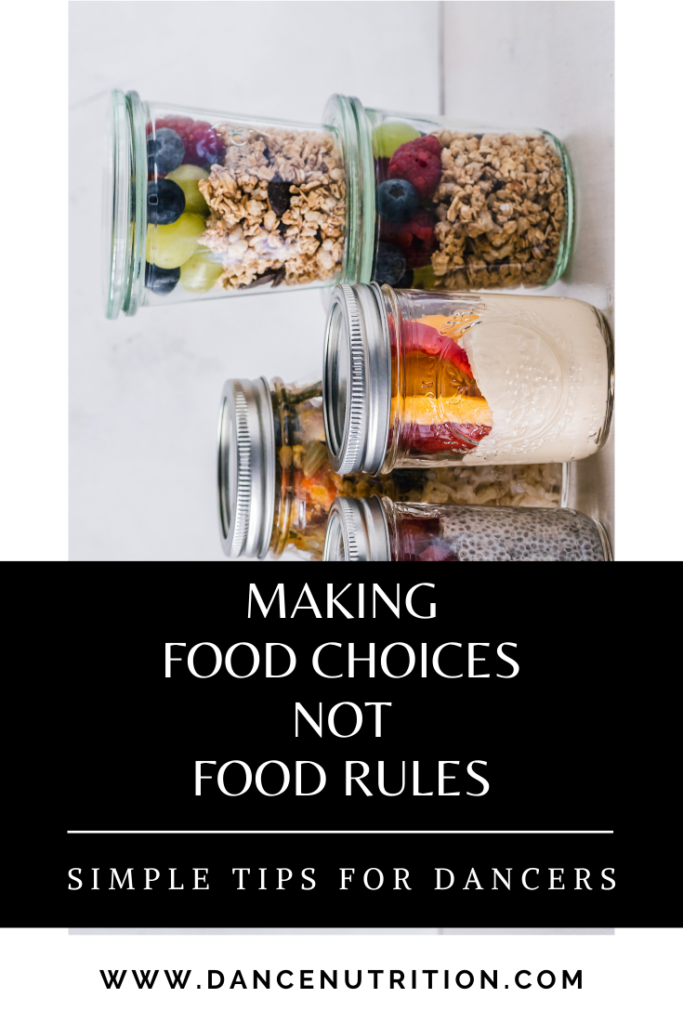You’re walking along the aisles of your supermarket and stop upon what seems like an endless supply of bread. Without hesitation, you spot a darker loaf that reads “Made With Whole Grains and Seeds.” You skim the back label and add it to your bag. Within the same minute, you second-guess your choice for a more appealing fluffier “white” loaf but since you’ve read that fiber is “healthy,” you skip it and move on. Was your bread choice the right one?
For dancers, understanding the difference between food rules and choices can help you cultivate a healthier approach to eating. In this blog post, we’ll explore these concepts and offer practical tips to ensure you’re making nourishing choices rather than restrictive rules.
Food Rules: Restrictive and Rigid
Food rules are pre-conceived thoughts that stem from external sources of information. They are often characterized by rigid, black-and-white thinking about what you should or shouldn’t eat. These rules can stem from diet culture, misinformation, or personal beliefs about food. Here are examples:
- No carbs after 8 PM.
- Sugar is bad; avoid it completely.
- Only eat organic foods.
- Never eat processed foods.
- Avoid white bread because it’s unhealthy.
- Order salads at restaurants because they’re lower in calories.
- Eat dark chocolate because it’s much healthier than milk chocolate.
While these rules might seem like they’re promoting health, they can lead to unhealthy behaviors, such as:
- Disordered Eating: Strict food rules can contribute to disordered eating patterns, and feeling guilty or anxious when you break a rule.
- Nutrient Deficiencies: By avoiding certain food groups, you might miss out on essential nutrients necessary for your performance and health.
- Mealtime Stress: The constant monitoring and restriction of food intake can cause mental stress and take the joy out of eating.
Most often, food rules don’t consider your life’s or your body’s experiences— previous memories, tastes, flavors, or physical feelings such as stomach discomfort or increased energy levels. In short: food rules strip the fun from eating.
Food Choices: Flexible and Empowering
In contrast, are food choices. Flexible and guided by your body’s needs, preferences, experiences, and circumstances. Making food choices means listening to your hunger and fullness cues, understanding your nutritional needs, and allowing yourself to enjoy food without guilt. For example, instead of choosing the high-fiber bread “because it’s healthier,” you might choose the option because it helps keep your bowels regular and your energy sustained. Here are examples:
- Choosing whole grain bread because it’s heartier and keeps me fuller and more energized.
- Eating a high-protein snack after dancing to hold me until dinner and support muscle recovery.
- Choosing dark chocolate because of a flavor preference
- Choosing chocolate chip cookies because they’re available and enjoyable.
Key aspects of food choices include:
- A food-neutral lens by enjoying foods without labeling them as “good” or “bad.”
- Food flexibility at mealtimes, accounting for circumstances and what’s accessible.
- Gentle nutrition when constructing meals and snacks to achieve a balanced and varied intake from a range of foods and food groups.
Swapping Food Rules with Food Choices
Inflexibility is a major characteristic that separates food rules from food choices. If the “right” option (or what aligns with your food rules) is unavailable, you feel guilty and anxious. This quickly turns an opportunity to fuel into a consuming and confusing experience. Consider these strategies to begin swapping food rules, with supportive food choices.
#1: Educate Yourself
First, evaluate your current eating habits and attitudes toward food. Are there any rules you’re following that aren’t serving you well? Will you feel guilty, stressed, or anxious if foods deemed “acceptable” are unavailable? Next, you’ll want to learn about nutrition from credible sources. Understanding the role of different nutrients can help you make informed food choices. Instead, focus on how foods contribute to your overall health and performance. This work must be done carefully, as an over-emphasis on nutrition can worsen the tendency to categorize foods as “good” or “bad.” A registered dietitian, particularly one specializing in dancer nutrition, can provide personalized advice to help you meet your nutritional needs without resorting to restrictive rules.
As you identify and detangle your food rules, work on replacing them with more flexible choices. Here are a few articles to help:
#2: Consider Flexibility and Proactive Fueling
Keep a variety of foods on hand to make balanced meals and snacks easily accessible. This can prevent the need for strict rules when you’re busy or stressed. Be adaptable with your eating habits. Understand that it’s okay to deviate from your usual eating patterns, especially during special occasions or when you have different energy needs. Here are a few articles to help in these instances:
#3: Prioritize Body Attunement
Pay attention to your preferences, enjoyments, and experiences with food. Notice your appetite cues— hunger, fullness, and satisfaction. Keep in mind that if you’ve restricted your intake for a long period, these cues may be nonexistent. When eating, practice mindfulness by slowing down and noticing the textures, flavors, and how the food makes you feel.



